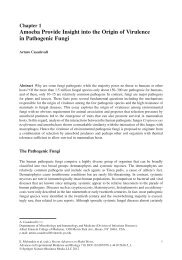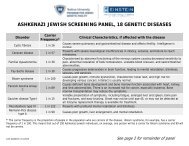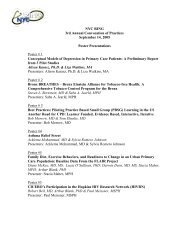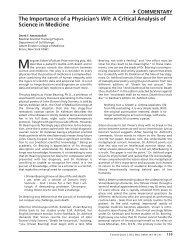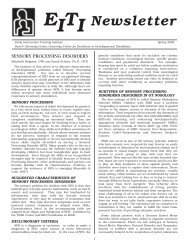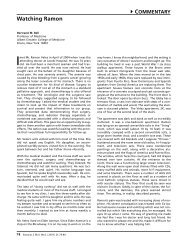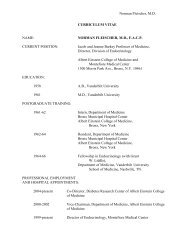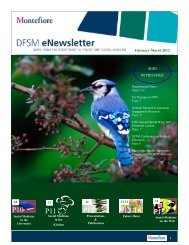Congenital Melanocytic Nevi and the Risk of Malignant Melanoma ...
Congenital Melanocytic Nevi and the Risk of Malignant Melanoma ...
Congenital Melanocytic Nevi and the Risk of Malignant Melanoma ...
You also want an ePaper? Increase the reach of your titles
YUMPU automatically turns print PDFs into web optimized ePapers that Google loves.
4MEDICAL REVIEWS<br />
<strong>Congenital</strong> <strong>Melanocytic</strong> <strong>Nevi</strong> <strong>and</strong> <strong>the</strong> <strong>Risk</strong> <strong>of</strong> <strong>Malignant</strong><br />
<strong>Melanoma</strong>: Establishing a Guideline for Primary-Care<br />
Physicians<br />
Jeremy Nikfarjam, MD1, <strong>and</strong> Earle Chambers, MPH, PhD2<br />
1Department <strong>of</strong> Surgery, Division <strong>of</strong> Plastic & Reconstructive Surgery, Montefiore Medical Center, Bronx, NY; 2Department <strong>of</strong> Family <strong>and</strong> Social<br />
Medicine, Department <strong>of</strong> Epidemiology & Population Health, Albert Einstein College <strong>of</strong> Medicine, Bronx, NY<br />
Objective: The objective <strong>of</strong> this review is to determine what<br />
size congenital melanocytic nevi (CMN) increases <strong>the</strong> risk <strong>of</strong><br />
malignant melanoma in affected patients.<br />
Background: <strong>Congenital</strong> melanocytic nevi are benign proliferations<br />
<strong>of</strong> cutaneous melanocytes apparent at birth or in <strong>the</strong><br />
first postnatal weeks. The Kopf system classifies nevi based<br />
on size: small,
4MEDICAL REVIEWS<br />
<strong>Congenital</strong> <strong>Melanocytic</strong> <strong>Nevi</strong> <strong>and</strong> <strong>the</strong> <strong>Risk</strong> <strong>of</strong> <strong>Malignant</strong> <strong>Melanoma</strong>: Establishing a Guideline for Primary-Care Physicians<br />
The inception <strong>of</strong> CMN in utero has not been definitively<br />
evidenced by imaging modalities or in utero studies.<br />
Never<strong>the</strong>less, Hamming (1983) reported a case <strong>of</strong> a<br />
“kissing nevus” in which a congenital melanocytic nevus<br />
developed on adjacent parts <strong>of</strong> <strong>the</strong> upper <strong>and</strong> lower<br />
eyelids <strong>and</strong> appeared as a single, contiguous lesion<br />
when <strong>the</strong> eyelids were closed. Based on this observation,<br />
CMN were estimated to develop between <strong>the</strong> 9th <strong>and</strong><br />
20th weeks <strong>of</strong> gestation.<br />
Histological analysis can aid in differentiating CMN from<br />
acquired nevi. Although <strong>the</strong>re are no pathognomonic<br />
features <strong>of</strong> CMN, histological analysis can be employed<br />
when CMN are suspected in <strong>the</strong> absence <strong>of</strong> documentation<br />
<strong>of</strong> nevus presence at birth (Cribier et al., 1999).<br />
In contrast to acquired nevi, nevomelanocytes <strong>of</strong> CMN<br />
proliferate in <strong>the</strong> subjacent dermal tissue <strong>and</strong> can<br />
spread to <strong>the</strong> deep dermis <strong>and</strong> even subcutis (Zaal et<br />
al., 2004). These nevomelanocytes can extend between<br />
collagen bundles <strong>of</strong> <strong>the</strong> reticular dermis, within <strong>and</strong><br />
around hair follicles, sebaceous gl<strong>and</strong>s, vessel walls, <strong>and</strong><br />
nerves (Mark et al., 1973; Rhodes et al., 1985; Barnhill<br />
<strong>and</strong> Fleischli, 1995). The depth <strong>and</strong> <strong>the</strong> pattern <strong>of</strong> nevus<br />
cell migration are directly related to <strong>the</strong> size <strong>of</strong> <strong>the</strong> CMN<br />
in infants (Barnhill <strong>and</strong> Fleischli, 1995). Never<strong>the</strong>less,<br />
nevus cell migration may continuously occur even after<br />
birth. Walton et al. (1976) studied biopsies <strong>of</strong> small CMN<br />
taken within 72 hours after birth, <strong>and</strong> concluded that<br />
<strong>the</strong> spread <strong>of</strong> congenital nevi into deeper layers <strong>of</strong> <strong>the</strong><br />
dermis <strong>and</strong> subcutis occurs largely after birth. In addition,<br />
Mark et al. (1973) demonstrated that <strong>the</strong> epidermal-dermal<br />
junction aspect <strong>of</strong> a nevus may disappear<br />
with time, rendering a dermal nevus without epidermal<br />
involvement. On <strong>the</strong> o<strong>the</strong>r h<strong>and</strong>, malignant melanoma<br />
arising within CMN usually originates at <strong>the</strong> epidermaldermal<br />
junction (Reed et al., 1965).<br />
Thus, <strong>the</strong> determination <strong>of</strong> malignancy is <strong>of</strong> far greater<br />
importance than <strong>the</strong> question <strong>of</strong> whe<strong>the</strong>r <strong>the</strong> nevus<br />
is congenital or acquired (Zaal et al., 2004). Studies<br />
attempting to quantify <strong>the</strong> percentage <strong>of</strong> primary melanoma<br />
originating from a CMN have shown inconsistent<br />
results. In a study conducted by Schmid-Wendtner et al.<br />
(2002), 9 <strong>of</strong> 6,931 (0.13%) patients under <strong>the</strong> age <strong>of</strong> 18<br />
years developed cutaneous melanoma associated with<br />
a congenital nevus. Previous to this analysis, Illig et al.<br />
(1985) reported that at least 2.8% <strong>of</strong> melanoma cases<br />
arose from congenital nevi, mostly those that were single<br />
<strong>and</strong> less than 10 cm. In a study assessing <strong>the</strong> risk <strong>of</strong><br />
melanoma from CMN in a lower-risk black population,<br />
Shpall et al. (1994) calculated an actual risk in blacks up<br />
to age 75 to be approximately 1 in 2,000 (0.05%). The<br />
level <strong>of</strong> risk reported among <strong>the</strong>se studies results varies<br />
from tenfold to a hundredfold <strong>and</strong> thus is <strong>of</strong> limited<br />
aid to clinicians in gauging <strong>the</strong> risk <strong>of</strong> malignancy in<br />
patients with CMN.<br />
Several studies assessing <strong>the</strong> lifetime risk <strong>of</strong> malignant<br />
melanoma from CMN based on size have been under-<br />
60 EJBM, Copyright © 2012<br />
taken in order to empower clinicians with practical <strong>and</strong><br />
simple measures for evaluating malignancy risk in <strong>the</strong>ir<br />
patients. Among patients with giant CMN, a lifetime risk<br />
<strong>of</strong> malignancy <strong>of</strong> 5% to 60% has been reported in <strong>the</strong><br />
literature (Kaplan, 1974; Kang et al., 1992; Sober <strong>and</strong><br />
Burstein, 1995). Marghoob et al. (1996) concluded a<br />
lifetime increased risk <strong>of</strong> 3.3% for melanoma in large<br />
CMN measuring 20 cm or more in largest diameter, or<br />
CMN predicted to attain this size by adulthood. Quaba<br />
<strong>and</strong> Wallace (1986) calculated an 8.52% lifetime risk for<br />
melanoma in a retrospective analysis <strong>of</strong> 39 patients with<br />
giant CMN.<br />
Among patients with medium <strong>and</strong> small-sized CMN, <strong>the</strong><br />
risk <strong>of</strong> transformation to malignant melanoma seems to<br />
be controversial. Scalzo et al. (1997) <strong>of</strong> <strong>the</strong> Massachusetts<br />
General Hospital Pigmented Lesion Clinic reported that<br />
in a 30-year period, no child (
<strong>Congenital</strong> <strong>Melanocytic</strong> <strong>Nevi</strong> <strong>and</strong> <strong>the</strong> <strong>Risk</strong> <strong>of</strong> <strong>Malignant</strong> <strong>Melanoma</strong>: Establishing a Guideline for Primary-Care Physicians<br />
review is to answer <strong>the</strong> following question: What size<br />
CMN increases <strong>the</strong> risk <strong>of</strong> malignant melanoma in <strong>the</strong><br />
affected patients?<br />
METHODS<br />
A literature search was performed using <strong>the</strong> biomedical<br />
bibliographical database Medline from 1966 to<br />
December 2008. Initial searches used <strong>the</strong> keywords “congenital<br />
nevus,” “congenital melanocytic nevus,” <strong>and</strong><br />
“congenital nevocellular nevus.” We included studies<br />
on medium, large, <strong>and</strong> giant congenital nevi in association<br />
with melanoma. We excluded all articles that were<br />
not prospective analyses <strong>and</strong>/or case-control studies,<br />
articles with five or fewer CMN patients, articles that<br />
dealt only with aspects <strong>of</strong> treatment, articles that classified<br />
size by methods o<strong>the</strong>r than <strong>the</strong> Kopf model, <strong>and</strong><br />
data presented in letters to <strong>the</strong> editor <strong>and</strong> abstracts. The<br />
remaining studies were individually placed into Google<br />
Scholar, <strong>and</strong> were selected based on <strong>the</strong> number <strong>of</strong><br />
citations received. Manual cross-referencing was performed.<br />
Finally, one representative article was selected<br />
with respect to CMN classification by size: small CMN,<br />
medium CMN, <strong>and</strong> large CMN.<br />
RESULTS<br />
No prospective studies met our search criteria for small<br />
CMN, so a case-control study was included with <strong>the</strong><br />
caveat that a prospective study is preferred over a casecontrol<br />
study for our particular assessment.<br />
Three studies pertaining to small, medium, <strong>and</strong> large<br />
CMN met our inclusion criteria. The results are shown<br />
in Table 1.<br />
The first article reviewed is by Rhodes <strong>and</strong> Melski (1982):<br />
“Small congenital nevocellular nevi <strong>and</strong> <strong>the</strong> risk <strong>of</strong> cutaneous<br />
melanoma.” This case-control study was created<br />
to determine <strong>the</strong> odds ratio <strong>of</strong> melanoma for persons<br />
with small congenital nevi (SCN). This was done by<br />
comparing <strong>the</strong> frequency <strong>of</strong> SCN in unselected cases <strong>of</strong><br />
melanoma to <strong>the</strong> frequency <strong>of</strong> SCN in newborn infants.<br />
Postpubertal patients with all histological types <strong>of</strong> cutaneous<br />
melanoma invasive to at least <strong>the</strong> papillary dermis<br />
were included <strong>and</strong> divided into three groups.<br />
The first group was composed <strong>of</strong> 134 patients who<br />
reported a detailed history <strong>of</strong> preexisting pigmented<br />
lesions (PPLs) at <strong>the</strong> tumor site, but whose tumors were<br />
not histologically examined for melanoma-associated<br />
nevocellular nevi. The 134 patients included 67 males<br />
<strong>and</strong> 67 females with an age range <strong>of</strong> 16–78 years (mean<br />
= 47.9 years) with histological documentation <strong>of</strong> primary<br />
cutaneous melanoma diagnosed between April 1960<br />
<strong>and</strong> September 1979 at <strong>the</strong> Pigmented Lesion Clinic <strong>of</strong><br />
Massachusetts General Hospital. In this study group, 33<br />
4MEDICAL REVIEWS<br />
patients were diagnosed at <strong>the</strong> time <strong>of</strong> interview, 40<br />
patients were interviewed within one year <strong>of</strong> diagnosis,<br />
23 patients were interviewed between one <strong>and</strong> two<br />
years <strong>of</strong> diagnosis, <strong>and</strong> 38 patients were interviewed<br />
later than two years after diagnosis. Interviews included<br />
questions to assess <strong>the</strong> first appearance <strong>and</strong> morphological<br />
characteristics <strong>of</strong> <strong>the</strong> PPLs, along with <strong>the</strong> source <strong>of</strong><br />
<strong>the</strong> information obtained (parents versus patient).<br />
The second group was composed <strong>of</strong> 234 patients who<br />
did not report a detailed history <strong>of</strong> a PPL at <strong>the</strong> tumor<br />
site, but whose tumors were histologically examined for<br />
<strong>the</strong> presence <strong>of</strong> melanoma-associated nevocellular nevi.<br />
The 234 patients included 119 males <strong>and</strong> 115 females;<br />
1 patient was black <strong>and</strong> 233 were white, with an age<br />
range <strong>of</strong> 12 to 90 years (mean = 47.9 years). Histology<br />
was determined in 234 unselected melanoma specimens<br />
entered into <strong>the</strong> Harvard <strong>Melanoma</strong> Registry within 30<br />
days <strong>of</strong> diagnosis during <strong>the</strong> period from September<br />
1, 1972, to May 30, 1977. Tumor-associated nevi were<br />
examined to determine whe<strong>the</strong>r <strong>the</strong>y were nevocellular<br />
nevi with congenital features based on <strong>the</strong> presence <strong>of</strong><br />
nevus cells in <strong>the</strong> dermis.<br />
Data on <strong>the</strong> third group <strong>of</strong> patients were obtained<br />
from a previous study by Walton et al. (1976) in order<br />
to determine <strong>the</strong> prevalence <strong>of</strong> congenital nevocellular<br />
nevi by histology in 841 white newborn neonates examined<br />
within 72 hours <strong>of</strong> birth.<br />
Finally, <strong>the</strong> data from all <strong>the</strong> groups were used to calculate<br />
an odds ratio for primary cutaneous melanoma<br />
associated with SCN. This was done by dividing <strong>the</strong> exposure<br />
odds <strong>of</strong> SCN among patients with melanoma by <strong>the</strong><br />
exposure odds <strong>of</strong> SCN among neonates.<br />
Results <strong>of</strong> <strong>the</strong> Rhodes <strong>and</strong> Melski (1982) study were<br />
determined based on <strong>the</strong> sample groups. Of <strong>the</strong> 134<br />
patients with melanoma in <strong>the</strong> first group, 20 (14.9%)<br />
gave a detailed history <strong>of</strong> <strong>the</strong> existence <strong>of</strong> a PPL at <strong>the</strong><br />
tumor site present since birth. Out <strong>of</strong> <strong>the</strong>se 20 cases, 5<br />
were ascertained by direct interview with parents (2 <strong>of</strong><br />
which cases had photographs during <strong>the</strong> first 6 months<br />
<strong>of</strong> life), whereas <strong>the</strong> o<strong>the</strong>r 15 were ascertained indirectly<br />
by parental statements in <strong>the</strong> past. Among <strong>the</strong>se<br />
20 patients, <strong>the</strong> estimated greatest diameter for <strong>the</strong> PPL<br />
ranged from 3 to 15 mm (mean = 9 mm +/- 4 mm). Out <strong>of</strong><br />
<strong>the</strong> 234 melanoma specimens in <strong>the</strong> first group who did<br />
not report a detailed history <strong>of</strong> a PPL at <strong>the</strong> tumor site,<br />
19 (8.1%) were designated tumor-associated nevocellular<br />
nevi with congenital features. Fur<strong>the</strong>rmore, out <strong>of</strong><br />
<strong>the</strong>se 19 cases, a total <strong>of</strong> 6 (2.6%) had nevus cells in <strong>the</strong><br />
lower two thirds <strong>of</strong> <strong>the</strong> reticular dermis (a highly sensitive<br />
indicator <strong>of</strong> congenital nevi). Of <strong>the</strong> 30 patients who<br />
were included in both groups, 2 patients were among<br />
<strong>the</strong> 20 PPLs in <strong>the</strong> first group, <strong>and</strong> 2 different patients<br />
were among <strong>the</strong> 19 tumor-associated nevocellular nevi<br />
with congenital features specimens in <strong>the</strong> second group.<br />
Of <strong>the</strong> Walton et al. (1976) third study group, 7 patients<br />
The Einstein Journal <strong>of</strong> Biology <strong>and</strong> Medicine 61
4MEDICAL REVIEWS<br />
<strong>Congenital</strong> <strong>Melanocytic</strong> <strong>Nevi</strong> <strong>and</strong> <strong>the</strong> <strong>Risk</strong> <strong>of</strong> <strong>Malignant</strong> <strong>Melanoma</strong>: Establishing a Guideline for Primary-Care Physicians<br />
TABLE 1. AN OVERVIEW OF LITERATURE ON MELANOMA AND CONGENITAL MELANOCYTIC NEVI<br />
(CMN Type according to Kopf et al. [1979]. CMN[n] – Number <strong>of</strong> subjects with CMN in study. MM – <strong>Malignant</strong> melanoma)<br />
(0.83%) had nevocellular nevi confirmed by biopsy, all <strong>of</strong><br />
which were ≤3.0 cm in greatest diameter. Based on <strong>the</strong>se<br />
results, <strong>the</strong> study determined an odds ratio for cutaneous<br />
melanoma in persons with SCN to be 20.9 based<br />
on history (95% confidence interval 11.0 to 39.9) <strong>and</strong><br />
10.5 based on histology (95% confidence interval 5.1 to<br />
21.6). The odds ratio was 3.1 for <strong>the</strong> 6 specimens taken<br />
from <strong>the</strong> 19 nevocellular nevi with congenital features.<br />
The authors concluded that congenital nevi <strong>of</strong> any size<br />
may be precursors to cutaneous melanoma.<br />
The Rhodes <strong>and</strong> Melski (1982) study was among <strong>the</strong> first<br />
studies to address <strong>the</strong> risk <strong>of</strong> malignant melanoma in<br />
patients with SCN. The study methodology <strong>of</strong> distinguishing<br />
three different subject groups fur<strong>the</strong>r aided in<br />
minimizing confounding effects <strong>of</strong> various o<strong>the</strong>r parameters<br />
that were not controlled. In addition, by separating<br />
patients based on history versus tissue diagnosis, <strong>the</strong><br />
authors were able to note a difference in <strong>the</strong> odds ratio,<br />
possibly raising <strong>the</strong> issue that PPL history alone may<br />
overestimate <strong>the</strong> odds ratio <strong>of</strong> melanoma.<br />
Although <strong>the</strong> authors’ conclusion may ultimately be<br />
supported by <strong>the</strong>ir data, <strong>the</strong> methodology in calculating<br />
<strong>the</strong> odds ratio is inherently flawed. Information<br />
62 EJBM, Copyright © 2012<br />
from <strong>the</strong> patients in <strong>the</strong> first subject group was in some<br />
cases not obtained directly from <strong>the</strong> patients or families.<br />
Among those cases in which information was directly<br />
obtained, only two had photographic evidence <strong>of</strong> <strong>the</strong><br />
PPL. Thus, great subjectivity in <strong>the</strong> form <strong>of</strong> recall bias<br />
during patient interviews is likely to confound <strong>the</strong> estimation<br />
<strong>of</strong> PPL size. In <strong>the</strong> second subject group, nearly<br />
two times more patients were present than in <strong>the</strong> first<br />
group. Though more subjects contribute to <strong>the</strong> power <strong>of</strong><br />
<strong>the</strong> study results, it is optimal to have close to an equal<br />
number <strong>of</strong> subjects in both groups in order to minimize<br />
<strong>the</strong> effects <strong>of</strong> statistical outliers. Among <strong>the</strong> 30 patients<br />
in <strong>the</strong> third subject group, 2 reported a history <strong>of</strong> PPL<br />
(6.66%) <strong>and</strong> 2 o<strong>the</strong>rs had positive histology (6.66%).<br />
These results were substantially different from those in<br />
<strong>the</strong> first group (14.9%) <strong>and</strong> <strong>the</strong> second group (2.6%),<br />
raising <strong>the</strong> issue <strong>of</strong> <strong>the</strong> accuracy <strong>of</strong> <strong>the</strong> study results.<br />
Finally, <strong>the</strong> authors chose to use <strong>the</strong> study by Walton et<br />
al. (1976) to estimate <strong>the</strong> prevalence rate <strong>of</strong> SCN. This<br />
is also represents a flaw in study design because <strong>the</strong><br />
authors make <strong>the</strong> assumption that prevalence <strong>of</strong> SCN in<br />
newborn infants is constant <strong>and</strong> that <strong>the</strong> prevalence <strong>of</strong><br />
SCN in adults is comparable to that in neonates.<br />
The second report considered here, “<strong>Risk</strong> <strong>of</strong> melanoma
<strong>Congenital</strong> <strong>Melanocytic</strong> <strong>Nevi</strong> <strong>and</strong> <strong>the</strong> <strong>Risk</strong> <strong>of</strong> <strong>Malignant</strong> <strong>Melanoma</strong>: Establishing a Guideline for Primary-Care Physicians<br />
in medium-sized congenital melanocytic nevi: A followup<br />
study,” by Sahin et al. (1998), is a prospective, clinical<br />
cohort study created to assess <strong>the</strong> risk for melanoma in<br />
individuals with medium-sized melanocytic nevi clinically<br />
judged to be congenital. Methodology consisted<br />
<strong>of</strong> a chart review <strong>of</strong> patients first seen from November<br />
1955 to September 1996 in a private dermatology clinic<br />
in order to identify cases <strong>of</strong> medium-sized CMN. The following<br />
data were taken from <strong>the</strong> chart: each patient’s<br />
age at initial visit <strong>and</strong> last follow-up <strong>and</strong> <strong>the</strong> anatomic<br />
location, shape, size, elevation, surface characteristics<br />
(presence <strong>of</strong> hair), <strong>and</strong> color <strong>of</strong> <strong>the</strong> patient’s lesion.<br />
The only inclusion criterion established was a Polaroid<br />
photograph taken <strong>of</strong> <strong>the</strong> CMN for clinical diagnosis.<br />
Lesions smaller than 1.5 cm in greatest diameter <strong>and</strong><br />
those greater than 19.9 cm in greatest diameter were<br />
excluded, without an attempt to predict adult sizes <strong>of</strong><br />
CMN smaller than 1.5 cm in greatest diameter. In total,<br />
16,871 charts were reviewed, yielding 329 patients with<br />
Polaroid photographs <strong>of</strong> lesions that met inclusion criteria<br />
for CMN. These patients or parents <strong>of</strong> <strong>the</strong> patients<br />
were contacted <strong>and</strong> asked whe<strong>the</strong>r <strong>the</strong>re had been a<br />
change in <strong>the</strong> CMN, whe<strong>the</strong>r a malignant melanoma had<br />
developed within <strong>the</strong> CMN or elsewhere, <strong>and</strong> when <strong>and</strong><br />
how <strong>the</strong> CMN had been treated. Out <strong>of</strong> <strong>the</strong> 329 patients,<br />
102 patients with less than one year <strong>of</strong> follow-up were<br />
excluded. The remaining 227 patients (230 CMN) were<br />
enrolled in <strong>the</strong> study. An additional follow-up via telephone<br />
was carried out with 174 <strong>of</strong> <strong>the</strong>se patients.<br />
Results <strong>of</strong> <strong>the</strong> Sahin et al. (1998) study were based on<br />
demographic data <strong>and</strong> clinical characteristics <strong>of</strong> <strong>the</strong> CMN<br />
entered into <strong>the</strong> study. CMN were first seen at an average<br />
age <strong>of</strong> 19 years (median, 12 years) with an average<br />
age at last follow-up <strong>of</strong> 25.5 years (median, 19 years).<br />
The average follow-up period was 6.7 years (median, 5.8<br />
years). The largest diameters <strong>of</strong> CMN ranged from 15 to<br />
190 mm, with an average <strong>of</strong> 40 mm. No patients developed<br />
malignant melanoma in medium-sized congenital<br />
nevi during follow-up. However, three patients who met<br />
<strong>the</strong> inclusion criteria developed melanoma at anatomic<br />
sites o<strong>the</strong>r than those were <strong>the</strong> CMN were located. One<br />
<strong>of</strong> <strong>the</strong>se patients developed melanoma during followup,<br />
ano<strong>the</strong>r patient had melanoma before <strong>the</strong> initial<br />
visit, <strong>and</strong> a third patient had been diagnosed with three<br />
melanomas, two before his first visit <strong>and</strong> one during<br />
follow-up. Based on <strong>the</strong>se results, <strong>the</strong> authors concluded<br />
that medium-sized congenital nevi are not at increased<br />
risk <strong>of</strong> developing into melanoma.<br />
Several methodological attributes <strong>of</strong> <strong>the</strong> study by Sahin<br />
et al. (1998) contributed to <strong>the</strong> soundness <strong>of</strong> <strong>the</strong> authors’<br />
conclusion <strong>and</strong> limited <strong>the</strong> confounding factors. First,<br />
<strong>the</strong> patient data taken from <strong>the</strong> chart review allowed<br />
<strong>the</strong> authors to define <strong>the</strong> characteristics <strong>of</strong> medium CMN<br />
<strong>and</strong> melanoma. Second, each nevus was documented by a<br />
Polaroid photograph, providing evidence <strong>of</strong> a skin lesion<br />
preceding a melanoma. Third, <strong>the</strong> relatively large initial<br />
sample size <strong>of</strong> 329 patients with medium CMN increased<br />
4MEDICAL REVIEWS<br />
<strong>the</strong> power <strong>of</strong> <strong>the</strong> study results. However, certain flaws in<br />
<strong>the</strong> study design did exist. First, <strong>the</strong> authors determined<br />
whe<strong>the</strong>r <strong>the</strong> nevus was congenital by clinical characteristics.<br />
These are inherently subjective inclusion criteria,<br />
as nevi are known to evolve with respect to clinical<br />
appearance. Second, among <strong>the</strong> 227 patients ultimately<br />
enrolled in <strong>the</strong> study, only 174 received follow-up; while<br />
those patients lost to follow-up were not known to have<br />
developed melanoma, <strong>the</strong> loss <strong>of</strong> this potentially valuable<br />
data from <strong>the</strong> study is considerable. Fur<strong>the</strong>rmore,<br />
<strong>the</strong> average length <strong>of</strong> follow-up was merely 6.7 years<br />
from an average patient age <strong>of</strong> 19 years, an interval<br />
that may not be adequate to observe transformation <strong>of</strong><br />
medium CMN to melanoma. Finally, among <strong>the</strong> patients<br />
with follow-up, <strong>the</strong> authors mentioned that <strong>the</strong>y were<br />
asked “whe<strong>the</strong>r an MM [malignant melanoma] had<br />
developed within <strong>the</strong> CMN or elsewhere.” Once again,<br />
without tissue diagnosis, this introduced subjectivity <strong>and</strong><br />
bias into <strong>the</strong> study design because patients may have<br />
had undiagnosed melanoma, or, conversely, may mistakenly<br />
have stated that <strong>the</strong>y had melanoma without an<br />
actual diagnosis.<br />
The third article reviewed, “Giant pigmented nevi:<br />
Clinical, histopathologic, <strong>and</strong> <strong>the</strong>rapeutic considerations,”<br />
by Ruiz-Maldonado et al. (1992), is a prospective,<br />
clinical cohort study created to assess <strong>the</strong> clinical<br />
<strong>and</strong> histopathologic features, as well as <strong>the</strong> treatment <strong>of</strong><br />
giant CMN. This was done by entering all patients clinically<br />
diagnosed with giant pigmented nevus (defined<br />
<strong>the</strong>rein as cutaneous hamartomas <strong>of</strong> nevomelanocytes<br />
measuring ≥20 cm in diameter) during <strong>the</strong> period from<br />
January 1971 to December 1990 at <strong>the</strong> Department <strong>of</strong><br />
Dermatology at <strong>the</strong> National Institute <strong>of</strong> Pediatrics in<br />
Mexico City. The sole inclusion criterion was <strong>the</strong> presence<br />
<strong>of</strong> a giant pigmented nevus. Each <strong>of</strong> <strong>the</strong> 80 patients<br />
enrolled in <strong>the</strong> study received a physical examination,<br />
routine laboratory tests (blood cell counts, chemistry<br />
studies, urinalysis), <strong>and</strong> nevus biopsy. Patients with nevi<br />
involving <strong>the</strong> skin overlying <strong>the</strong> head or upper portion<br />
<strong>of</strong> <strong>the</strong> vertebral column received an electroencephalogram.<br />
Patients with extracutaneous abnormalities were<br />
examined by appropriate specialists.<br />
Results <strong>of</strong> <strong>the</strong> Ruiz-Maldonado et al. (1992) study<br />
included data for various parameters not mentioned in<br />
<strong>the</strong> methods section. The incidence <strong>of</strong> giant pigmented<br />
nevi was determined to be 1 in 4,150 among general<br />
pediatric outpatients, <strong>and</strong> 1 in 405 among pediatric<br />
dermatology outpatients (with 21% <strong>of</strong> patients lost to<br />
follow-up). The age <strong>of</strong> patients at <strong>the</strong> time <strong>of</strong> consultation<br />
ranged from 2 days to 16 years (mean = 20 months).<br />
The prevalence <strong>of</strong> giant pigmented nevi in girls (65% <strong>of</strong><br />
sample size) was found to be significantly greater than<br />
in boys (35% <strong>of</strong> sample size) (p
4MEDICAL REVIEWS<br />
<strong>Congenital</strong> <strong>Melanocytic</strong> <strong>Nevi</strong> <strong>and</strong> <strong>the</strong> <strong>Risk</strong> <strong>of</strong> <strong>Malignant</strong> <strong>Melanoma</strong>: Establishing a Guideline for Primary-Care Physicians<br />
lation (p
<strong>Congenital</strong> <strong>Melanocytic</strong> <strong>Nevi</strong> <strong>and</strong> <strong>the</strong> <strong>Risk</strong> <strong>of</strong> <strong>Malignant</strong> <strong>Melanoma</strong>: Establishing a Guideline for Primary-Care Physicians<br />
age in this study highlights <strong>the</strong> potential catastrophic<br />
harm that CMN possess in <strong>the</strong> event <strong>of</strong> malignant transformation.<br />
CONCLUSIONS<br />
Considering <strong>the</strong> results <strong>of</strong> this literature review, we have<br />
come to <strong>the</strong> following conclusions. First, <strong>the</strong> odds ratio<br />
calculated by Rhodes <strong>and</strong> Melski (1982) constitutes an<br />
important initial attempt to quantify <strong>the</strong> risk <strong>of</strong> small<br />
CMN transforming into melanoma, but more evidence<br />
is needed to properly evaluate <strong>the</strong> risk. Second, several<br />
shortcomings present in <strong>the</strong> Sahin et al. (1998) study<br />
likely limit <strong>the</strong> authors’ claim that medium-sized CMN<br />
do not impart an increased risk for melanoma. Third,<br />
despite <strong>the</strong> suboptimal methodology present in <strong>the</strong><br />
Ruiz-Maldonado et al. (1992) study, <strong>the</strong> evidence presented<br />
<strong>the</strong>rein is substantial <strong>and</strong> corroborates <strong>the</strong> risk <strong>of</strong><br />
melanoma from giant CMN.<br />
Based on this analysis, clinicians may consider several<br />
points in treating a patient with CMN. The consensus<br />
remains that each patient should receive a total body<br />
skin <strong>and</strong> mucosal surface exam for skin lesions upon<br />
initial presentation. Those patients with small CMN<br />
measuring
4MEDICAL REVIEWS<br />
<strong>Congenital</strong> <strong>Melanocytic</strong> <strong>Nevi</strong> <strong>and</strong> <strong>the</strong> <strong>Risk</strong> <strong>of</strong> <strong>Malignant</strong> <strong>Melanoma</strong>: Establishing a Guideline for Primary-Care Physicians<br />
Hamming, N. (1983). Anatomy <strong>and</strong> embryology <strong>of</strong> <strong>the</strong> eyelids: A review<br />
with special reference to <strong>the</strong> development <strong>of</strong> divided nevi. Pediatr Dermatol<br />
1(1):51–58.<br />
Illig, L., Weidner, F., Hundeiker, M., Gartmann, H., Biess, B., Leyh, F., <strong>and</strong> Paul, E.<br />
(1985). <strong>Congenital</strong> nevi less than or equal to 10 cm as precursors to melanoma:<br />
Fifty-two cases, a review, <strong>and</strong> a new conception. Arch Dermatol 121(10):1274–<br />
1281.<br />
Kang, S., Milton, G.W., <strong>and</strong> Sober, A.J. (1992). Childhood melanoma. In:<br />
Cutaneous <strong>Melanoma</strong>. Balch, C.M., Houghton, A.N, Milton, G.W., Sober, A.J.,<br />
<strong>and</strong> Soong, S-J. (eds.), J.B. Lippincott, Philadelphia. pp. 312–318.<br />
Kaplan, E.N. (1974). The risk <strong>of</strong> malignancy in large congenital nevi. Plast<br />
Reconstr Surg 53(4):421–428.<br />
Kopf, A.W., Bart, R.S., <strong>and</strong> Hennessey, P. (1979). <strong>Congenital</strong> nevocytic nevi <strong>and</strong><br />
malignant melanomas. J Am Acad Dermatol 1(2):123–130.<br />
Lanier, V.C., Jr., Pickrell, K.L., <strong>and</strong> Georgiade, N.G. (1976). <strong>Congenital</strong> giant<br />
nevi: Clinical <strong>and</strong> pathological considerations. Plast Reconstr Surg 58(1):48–54.<br />
Lens, M.B. <strong>and</strong> Dawes, M. (2004). Global perspectives <strong>of</strong> contemporary epidemiological<br />
trends <strong>of</strong> cutaneous malignant melanoma. Br J Dermatol<br />
150(2):179–185.<br />
Marghoob, A.A., Schoenbach, S.P., Kopf, A.W., Orlow, S.J., Nossa, R., <strong>and</strong> Bart,<br />
R.S. (1996). Large congenital melanocytic nevi <strong>and</strong> <strong>the</strong> risk for <strong>the</strong> development<br />
<strong>of</strong> malignant melanoma: A prospective study. Arch Dermatol 132(2):170–175.<br />
Mark, G.J., Mihm, M.C., Liteplo, M.G., Reed, R.J., <strong>and</strong> Clark, W.H. (1973).<br />
<strong>Congenital</strong> melanocytic nevi <strong>of</strong> <strong>the</strong> small <strong>and</strong> garment type: Clinical, histologic,<br />
<strong>and</strong> ultrastructural studies. Hum Pathol 4(3):395–418.<br />
Pratt, A.G. (1953). Birthmarks in infants. AMA Arch Dermatol Syphilol<br />
67(3):302–305.<br />
Quaba, A.A. <strong>and</strong> Wallace, A.F. (1986). The incidence <strong>of</strong> malignant melanoma<br />
(0 to 15 years <strong>of</strong> age) arising in “large” congenital nevocellular nevi. Plast<br />
Reconstr Surg 78(2):174–181.<br />
Reed, W.B., Becker, S.W., Sr., Becker, S.W., Jr., <strong>and</strong> Nickel, W.R. (1965). Giant<br />
pigmented nevi, melanoma, <strong>and</strong> leptomeningeal melanocytosis: A clinical <strong>and</strong><br />
histopathological study. Arch Dermatol 91:100–119.<br />
Rhodes, A.R., Albert, L.S., <strong>and</strong> Weinstock, M.A. (1996). <strong>Congenital</strong> nevomelanocytic<br />
nevi: Proportionate area expansion during infancy <strong>and</strong> early childhood.<br />
J Am Acad Dermatol 34(1):51–62.<br />
Rhodes, A.R. <strong>and</strong> Melski, J.W. (1982). Small congenital nevocellular nevi <strong>and</strong><br />
<strong>the</strong> risk <strong>of</strong> cutaneous melanoma. J Pediatr 100(2):219–224.<br />
Rhodes, A.R., Silverman, R.A., Harrist, T.J., <strong>and</strong> Melski, J.W. (1985). A histologic<br />
comparison <strong>of</strong> congenital <strong>and</strong> acquired nevomelanocytic nevi. Arch Dermatol<br />
121(10):1266–1273.<br />
66 EJBM, Copyright © 2012<br />
Ruiz-Maldonado, R., Tamayo, L., Laterza, A.M., <strong>and</strong> Durán, C. (1992). Giant<br />
pigmented nevi: Clinical, histopathologic, <strong>and</strong> <strong>the</strong>rapeutic considerations. J<br />
Pediatr 120(6):906–911.<br />
Sahin, S., Levin, L., Kopf, A.W., Rao, B.K., Triola, M., Koenig, K., Huang, C.,<br />
<strong>and</strong> Bart, R. (1998). <strong>Risk</strong> <strong>of</strong> melanoma in medium-sized congenital melanocytic<br />
nevi: A follow-up study. J Am Acad Dermatol 39(3):428–433.<br />
Scalzo, D.A., Hida, C.A., Toth, G., Sober, A.J., <strong>and</strong> Mihm, M.C., Jr. (1997).<br />
Childhood melanoma: A clinicopathological study <strong>of</strong> 22 cases. <strong>Melanoma</strong> Res<br />
7(1):63–68.<br />
Schmid-Wendtner, M.H., Berking, C., Baumert, J., Schmidt, M., S<strong>and</strong>er, C.A.,<br />
Plewig, G., <strong>and</strong> Volken<strong>and</strong>t, M. (2002). Cutaneous melanoma in childhood <strong>and</strong><br />
adolescence: An analysis <strong>of</strong> 36 patients. J Am Acad Dermatol 46(6):874–879.<br />
Soyer, H.P., Argenzian, G., H<strong>of</strong>mann-Wellenh<strong>of</strong>, R., <strong>and</strong> Johr, R. (2007). Color<br />
Atlas <strong>of</strong> <strong>Melanocytic</strong> Lesions <strong>of</strong> <strong>the</strong> Skin. Springer, Berlin <strong>and</strong> Heidelberg.<br />
Shpall, S., Frieden, I., Chesney, M., <strong>and</strong> Newman, T. (1994). <strong>Risk</strong> <strong>of</strong> malignant<br />
transformation <strong>of</strong> congenital melanocytic nevi in blacks. Pediatr Dermatol<br />
11(3):204–208.<br />
Sober, A.J. <strong>and</strong> Burstein, J.M. (1995). Precursors to skin cancer. Cancer 75(2<br />
suppl.):645–650.<br />
Swerdlow, A.J., English, J.S., <strong>and</strong> Qiao, Z. (1995). The risk <strong>of</strong> melanoma in<br />
patients with congenital nevi: A cohort study. J Am Acad Dermatol 32(4):595–<br />
599.<br />
Tsao, H., Atkins, M.B., <strong>and</strong> Sober, A.J. (2004). Management <strong>of</strong> cutaneous melanoma.<br />
N Engl J Med 351(10):998–1012.<br />
Walton, R.G., Jacobs, A.H, <strong>and</strong> Cox, A.J. (1976). Pigmented lesions in newborn<br />
infants. Br J Dermatol 95(4):389–396.<br />
Zaal, L.H., Mooi, W.J., Sillevis Smitt, J.H., <strong>and</strong> van der Horst, C.M. (2004).<br />
Classification <strong>of</strong> congenital<br />
melanocytic naevi <strong>and</strong> malignant transformation: A review <strong>of</strong> <strong>the</strong> literature.<br />
Br J Plast Surg 57(8):707–719.<br />
Corresponding Author: Address correspondence to Jeremy Nikfarjam, MD<br />
(jenikfar@montefiore.org).<br />
Conflict <strong>of</strong> Interest Disclosures: The authors have completed <strong>and</strong> submitted<br />
<strong>the</strong> ICMJE Form for Disclosure <strong>of</strong> Potential Conflicts <strong>of</strong> Interest. No conflicts<br />
were noted for ei<strong>the</strong>r author. Dr. Nikfarjam, a member <strong>of</strong> <strong>the</strong> EJBM Staff, was<br />
not involved in <strong>the</strong> review <strong>of</strong> this manuscript.<br />
Acknowledgements: The authors would like to thank Lorenzo Agoni, MD, MS<br />
for designing <strong>the</strong> figures in this manuscript.




